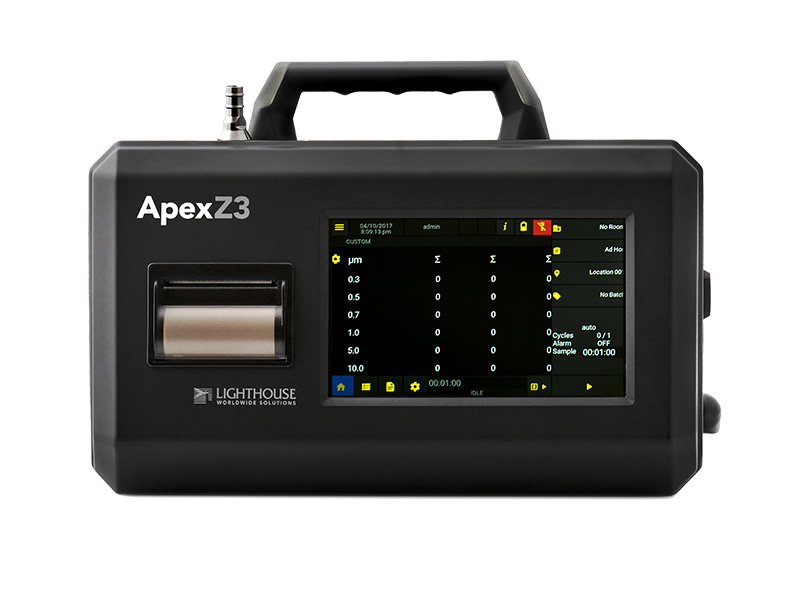When you need to classify your cleanroom, do you reach for your trusty photometer or particle counter? Both photometers and particle counters are devices used in cleanrooms to measure particles, but they go about it in different ways and report different data. According to ISO 14644, both are acceptable forms of testing for classification, especially after the 2019 updates. Yet the needs of each cleanroom are unique!
But which one proves right for your cleanroom? Depending on the use and size of your cleanroom, personal preferences, and data needs, you might find that one is a better fit for you than the other.
First things first, what are the differences between airborne particle counters and photometers?
What Is An Airborne Particle Counter?
An airborne particle counter is designed to measure the number and size of particles in a given space. There are a few different types of airborne particle counters: handheld particle counters, remote particle counters, and portable particle counters.
In order to test the number of particles in the air, the particle counter might pull air in to measure the particles using an internal vacuum. This is common for portable particle counters. Handheld particle counters typically don’t have this feature, so they take longer to give a reading. Remote particle counters are stationary, more permanent fixtures in the cleanroom, so they don’t usually require a vacuum.
Airborne particle counters use light scattering to measure the size and number of particles. Essentially, once air enters the particle counter, it is forced through a laser. This laser is shining onto a photodetector. So when the light is displaced, the particle counter is able to translate that data into the number and size of particles.
How much air is flowing through the airborne particle counter is considered the flow rate. This metric is one of the fundamentals of particle counters. If your particle counter is measuring the flow too quickly, it will read the particles as smaller and fewer than in reality. On the other hand, if the flow rate is too slow, the laser will detect the particles as larger and more prevalent than they really are.
What Is A Photometer?
Photometers don’t measure individual particles like airborne particle counters do, but they also use light scattering to measure total light scatter. They work to measure low concentrations of particles, but are designed to measure high concentrations.
So how are photometers used to test filter efficiency? Similar to a particle counter, air is pulled in through a sample inlet. As it is pushed towards the laser optic, it is surrounded by sheath air. Sheath air is filtered air that is used to keep all the particles in line. Since photometers are not measuring individual particle sizes, it just needs to read the total light scatter. Thus, the particles are pushed in mass through the laser optic then out through the manufacturer vacuum.
Since they don’t measure particle size or give fractional efficiency results, photometers are typically used with a particle counter device, like the ScanAir Pro. The addition of the device that quantifies results is necessary for many in their audit trails.
2019 ISO 14644-3 Updates
Both airborne particle counters and photometers are used to test filter efficiency. They can both be used to classify a cleanroom. In 2019, though, the International Organization for Standards (ISO) revised ISO 14644-3, their testing methods for cleanrooms and controlled environments.
Prior to 2019, it was harder to test a cleanroom with a photometer than a light scattering airborne particle counter. But part of the update allowed them to be directly comparable with an acceptance criteria of 0.01%.
This was due to a lightening of restrictions around choosing your testing method for classifying your cleanroom. The restrictions shifted to focus mainly on if you are using oil-based test aerosol with photometers which could hurt the end product.
Additionally, the designated leak acceptable has two limits now, depending on which filter class you are testing. Penetration is 0.01%, but for filters with MPPS 99.95% to 99.994%, the max penetration is 10x more (0.1%). This means that, essentially, HEPA filters rated H13 or ISO35H can now be tested against the 0.1% criteria.
Is A Photometer Or Airborne Particle Counter Right For Your Cleanroom?
According to ISO 14644 standards, you can use either a photometer or an airborne particle counter to classify your cleanroom. But you need to determine which is going to work best for you. So ask yourself the following questions:
- How big is your cleanroom or system of cleanrooms?
- How mobile do you need your testing method to be?
- Do you want a permanent, real-time monitoring solution?
- What are you using your cleanroom for?
- What is your industry standard and norm?
- What integrations do you need to be successful?
- What existing systems do you have that need to be integrated?
- What kind of data do you need as an output?
- What is your budget?
If you need more specific information, we would encourage you to look into airborne particle counters; however, photometers have their time and place.
The reality is that the best solution is a customized one. As the world’s clean air experts, we would be happy to work alongside you to determine the best solution for your unique situation and needs. No two cleanrooms are the same – so no two contamination control strategies should be the same.
For hassle-free, no obligation consultation, give us a call.


